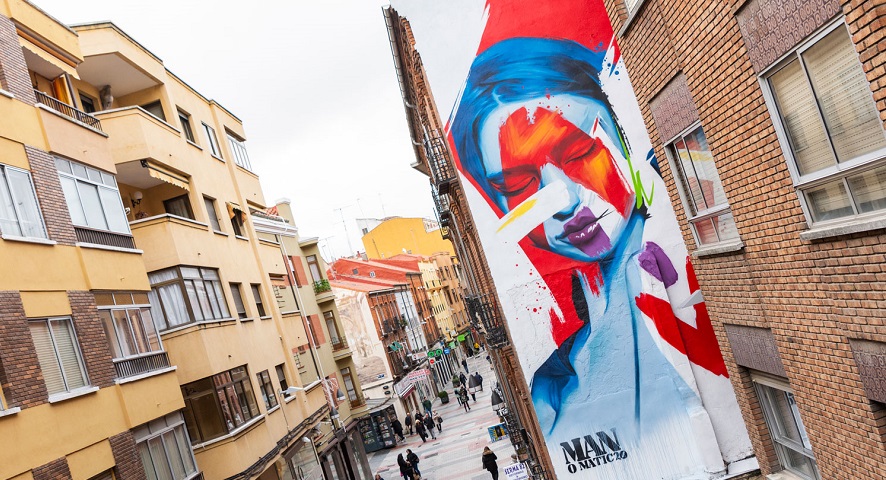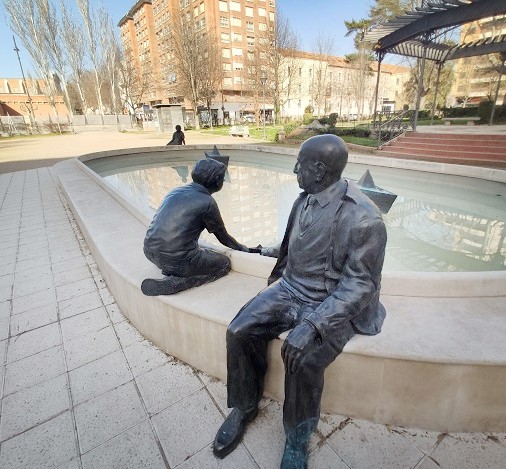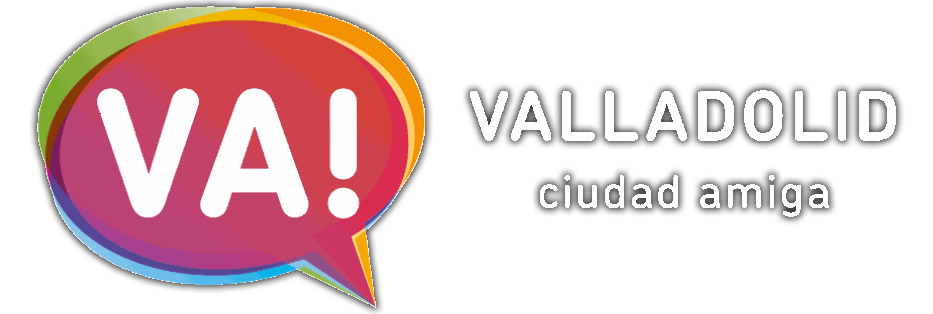Lugares - Arte urbano - Homenaje a Jorge Guillén
Breadcrumb
Breadcrumbs
Asset Publisher
Mural Art Route

Valladolid embraces urban art to reclaim forgotten corners of public spaces, creating a friendly city for its residents and an appealing destination for tourism.
Following in the footsteps of cities like Berlin, New York, and London, Valladolid started a grant program in 2016 to encourage local artists to decorate plain walls and facades, transforming them into genuine works of art.
Since 2019, the City Council and the association Andén 47 have collaborated closely, united by the goal of revitalizing the urban space through art. The project, renamed as the 'Vertical District,' maintains an ongoing call for property owners and community associations to offer their buildings as canvases (registrations can be made at distritovertical.org).
Mural Art Route: • Mantería Street, crossing with Simón Aranda Street - Mural by Gonzalo Borondo.
• Mantería Street - 'Khanya, Bearer of Light and Fire' mural from the Identity series by Manomatic, chosen by Widewalls portal as one of the best in 2020.
• Mantería Street, Simón Aranda Street 1 and 13, and Cervantes Theater - 'Cinco muñecos a pie de calle' by Kapone.
• López Gómez Street 24 - 'Mirar al futuro con alas de libertad, igualdad y respeto' by Eva Mena.
• Ricote Alley (Plaza Mayor, entrance of Pasión Street) - 'Time' by Clockers Colletive (David Fresno and Gonzalo de Miguel).
• Las Moreras Beach - Beach scenes by Inés García Candau.
• Gondomar Street, corner of Casa del Sol - 'Vera Fauna' by María Ruíz (Maru Rz).
• Estudios Street, next to Casa de Colón and Magdalena Church - 'Children's Paradyse. The Peak' by Henar Bayón.
• Estudios Street 10 - 'Estudio en la calle' by Daniel Muñoz.
• Casa del Estudiante (Calle Real de Burgos) - 'Two likes, one comment' by Javier Román.
• Gabilondo Street - Mural by Negro Maravilla.
• Porvenir Street - 'El selfie' by Diego Vicente, and 'El porvenir se define hoy' by Reskate.
• Surroundings of Arco de Ladrillo - Murals by Chais Martín and Rubén Cassasola.
• Arco de Ladrillo Bridge - Mural by Cuco / Javier Carrera.
• Golondrina Street - Mural by Sukha and Yksuhc in collaboration with the Pajarillos Educa project.
• Labradores Street tunnel - Intervention by students from the School of Art.
• Bailarín Vicente Escudero Civic Center (Vadillos) - 'El bailarín y la bailarina' by Javier Carreras 'Cuco'.
• San Pedro Regalado Sports Complex - 'Salida de emergencia' by DosJotas.
• Jardines del Parque Güell Street - Mural by Ruben Viard.
• Costa Dorada Street (Barrio España) - 'El éxodo rural y la pérdida de identidad, o cómo progresar sin perder las raíces' by Taquen.
• Montaña Street (Barrio España) - 'Autorización, nueva normalidad y horizonte' by Ampparito.
• Tierra de Campos Street (Barrio España) - Mural by Corte.
• CEARCAL (Valle de Arán Street, Barrio España) - 'Fortuna que canta, siempre se la lleva el aire'. Tribute to Zorrilla by FOACAL students.
• Cordillera Street with Santander Street (Barrio España) - 'Postales de barrio' by PincelArt Olid association.
• Pillars of the viaduct on Zamora Avenue, passing through Rueda Road - Futuristic murals by Nieves Peral and Javier Carrera, and 'Mr. Pain' mural by El Artista Polímata.
Navigation Menu
Asset Publisher
LOCATION
Widget tiempo Valladolid
Información turística
Tourist Office on Acera de Recoletos
Open Monday to Saturday from 9:30 a.m. to 2 p.m. and from 4 p.m. to 7 p.m. Sundays, from 9:30 a.m. to 2 p.m.
Phone: 983 21 93 10
Tourist Office on San Benito, Calle de San Benito s/n
Open Monday to Saturday from 10 a.m. to 2 p.m. and from 4 p.m. to 7 p.m. Sundays, from 10 a.m. to 2 p.m.
Phone: 983 42 61 93
Tourist Information Point at the Train Station
Open Tuesday to Saturday from 10 a.m. to 2 p.m. and from 4 p.m. to 7 p.m. Sundays, from 10 a.m. to 2 p.m.
Phone: 983 42 60 30
Media Gallery
Asset Publisher
Tribute to Jorge Guillén and Childhood
 This 'Tribute to Jorge Guillén and Childhood', inaugurated in 1998, is the work of sculptor Luis Santiago Pardo, who is also the author of the neighboring tribute to Rosa Chacel.
This 'Tribute to Jorge Guillén and Childhood', inaugurated in 1998, is the work of sculptor Luis Santiago Pardo, who is also the author of the neighboring tribute to Rosa Chacel. It is a representation in a hyper-realistic style and at life-size scale of the writer. The ensemble includes an oval-shaped pond, giving it an urbanistic component, on whose ledge Jorge Guillén rests alongside two children playing with paper boats in the water. As a tribute to the poet, the bronze boats 'sailing' in the pond bear the names of two of his most remembered works, 'Cántico' and 'Clamor'.
Jorge Guillén was born in 1893 on Constitution Street in Valladolid, where a bronze plaque can be seen marking his birthplace. This plaque is also the work of Luis Santiago Pardo. He resided in this city throughout his childhood and youth, and it is here where the outbreak of the Spanish Civil War caught him, an event that, like for so many Spaniards, would mark the rest of his life.
